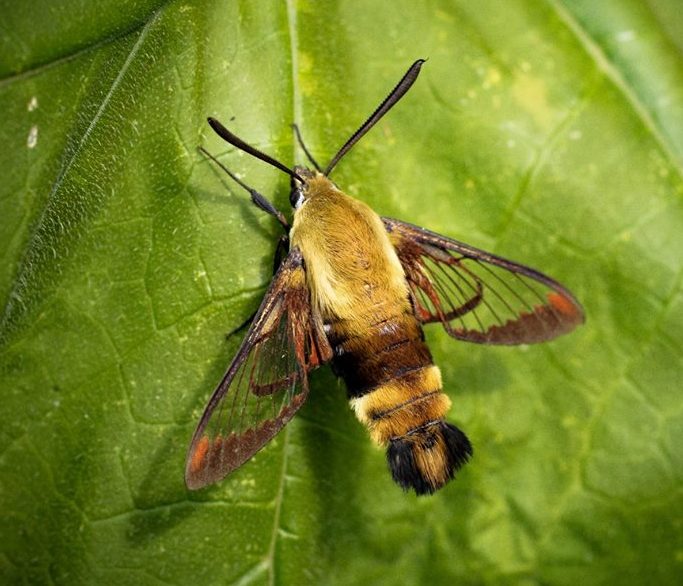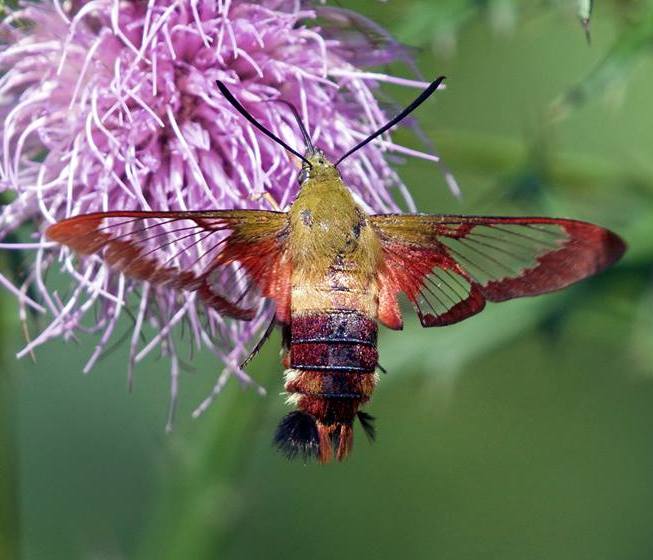ECOLOGY ▪ EDUCATION ▪ ADVOCACY



Hemaris: Hemara, a Greek word meaning “day,” is one possible explanation for this genus name since these moths are primary diurnal fliers. Another interpretation ties this Genus to the story of Pyramus and Thisbe; two ill-fated lovers who tragically kill themselves when they believe the other is dead, thus spilling their hema, the Greek word for “blood.” The blood-red scales present on the wings of Hemaris species is thought to be the connecting reason for the name. The epic tragedy was redone by many including William Shakespeare both in Romeo and Juliet and in A Midsummer Night's Dream, which included another ill-fated female named, Hermia.
HEM-ar-iss
Hemaris is a genus of moths in the family Sphingidae. Sometimes called “clearwing moths,” or “hummingbird moths“ there are over 20 described species worldwide, four of which occur in North America. Of those four, two species, Snowberry Clearwing (Hemaris diffinis) and Hummingbird Clearwing (H. thysbe) are common and widespread in Indiana, while one species, Slender Clearwing (H. gracilis) is uncommon, but occasionally seen.
The Indiana species of Hemaris can look very similar and, unfortunately, overall coloration is not a reliable way to tell these species apart. There are a few key field marks that help when determining whether you are viewing a Hummingbird Clearwing (Hemaris thysbe) or Snowberry Clearwing (Hemaris diffinis). Knowing where to look and what to look for will help as you learn to discern these closely related species.
Leg coloration: One of the more quick and simple ways to tell these species apart is to get a view of their legs.
Hummingbird Clearwing (H. thysbe) has pale to reddish colored legs. The first set of legs are the best set when looking for this field mark. The back two set of legs vary more in coloration.
Snowberry Clearwing (H. diffinis) has dark colored legs.
Wing venation: When viewing the wings of these two species, look closely at the discal cells on the forewings.
Hummingbird Clearwing (H. thysbe) has a discal cell that is bisected by a line of cells. The hindwing typically has a thick terminal border.
Snowberry Clearwing (H. diffinis) has a discal cell that is open, exposing more of the “see through” panel appearance similar to the other wing cells. The hindwing typically has a thinner terminal border.
Head/Thorax Stripe When viewing the species from the side, pay close attention to the markings on the side of the body.
Hummingbird Clearwing (H. thysbe) has an eye-line, but no bold striping travel past the head and no banding on the thorax.
Snowberry Clearwing (H. diffinis) has a bold stripe that extends from across its eye and then downward on the thorax before terminating behind the second set of legs.

Snowberry Clearwing (Hemaris diffinis) courtesy of Roger Harris. Hummingbird Clearwing (Hemaris thysbe) courtesy of Pamela Wang.